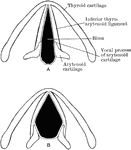
Human Lungs
Human lungs. 1 and 2 make up the larynx, or voice box. 1 is thyroid cartilage, 2 is cricoid cartilage.…

The lungs
"The lungs fill up most of the cavity of the chest. One lies on either side of the heart which is in…

Mouth
"The mouth, nose and pharynx, with the commencement of the gullet and larynx, as exposed by a section,…

The Mouth, Nose, and Pharynx
The mouth, nose, and pharynx, with the commencement of gullet (esophagus) and larynx, as exposed by…

The Mouth, Nose, and Pharynx
The mouth, nose, and pharynx, with the larynx and commencement of gullet (esophagus), seen in section.…

The Mouth, Nose, and Pharynx
The mouth, nose, and pharynx, with the commencement of the gullet (esophagus) and larynx, as exposed…

Nasal and throat passageways
"Diagram of a Sectional View of Nasal and Throat Passageways. C, nasal cavities; T,…

Anterior Part of Section Across Neck at False Vocal Cords
Anterior part of section across neck at level of false vocal cords; on left side ventricle of larynx…

Anterior Part of Section Across Neck at Fourth Cervical Vertebra
Anterior part of section across neck at level of fourth cervical vertebra, passing through upper part…

Cross Section of Neck at the 7th Cervical Vertebra
Modes of approach to the esophagus and the cervical sympathetic ganglion shown by means of a cross section…
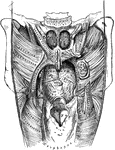
Muscles of the Soft Palate
Muscles of the soft palate, the pharynx being laid open from behind and mucous membrane removed.
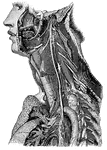
Trunk of the Pneumogastric Nerve
"Showing its distribution by its branches and ganglia to the larynx, pharynx, heart, lungs, and other…

Back View of Respiratory Apparatus
Outline showing the general form of the larynx, trachea, and bronchi, as seen from behind. Labels: h,…

Front View of Respiratory Apparatus
Outline showing the general form of the larynx, trachea, and bronchi, as seen from front. Labels: h,…
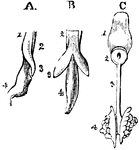
Development of Respiratory Organs
The development of the respiratory organs. A, is the esophagus of a chick on the fourth day of incubation,…
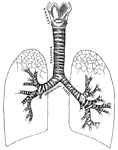
Respiratory system
"Larynx, trachea, and bronchi, showing the manner of division, and the rings of cartilage." —…

Respiratory System
The respiratory system. Labels: 1. the larynx; 2. the trachea; 3. right bronchia; 4. left bronchia;…
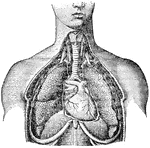
Respiratory System
The respiratory system. Labels: 1, larynx; 2, trachea; 3, right lung; 4, left lung; 5, heart.
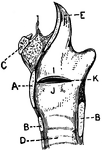
Vocal Cords Seen from above During Phonation
This illustration shows the vocal cords as seen from above during phonation (A. Thyroid Cartilage; B.…
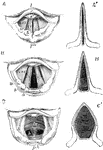
Movement of the Vocal Cords
Three laryngoscopic view of the superior aperture of the larynx and surrounding parts. Labels: A, the…

